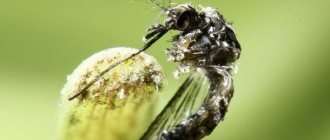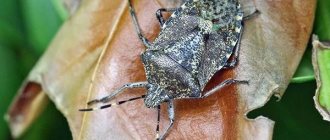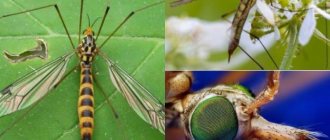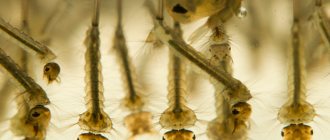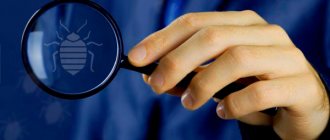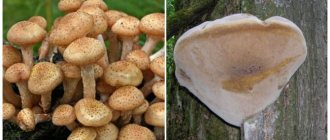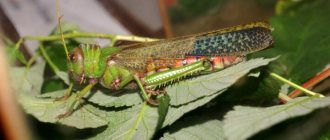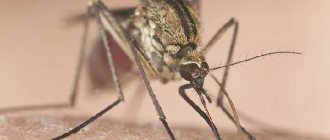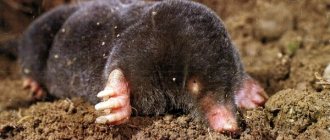Description of insects
What does a mosquito look like?
A mosquito under a microscope is not at all similar to the small insect that we are used to seeing on our bodies. If in an apartment you can still see them on the wall or light curtains, then on the street they are perfectly camouflaged and quietly attack the “victim”. The body of the insect, depending on the type of go, can be yellow, gray or brown. Its length can vary from one to one and a half centimeters. Considering the structure of an adult mosquito, we can conditionally divide its body into such components as the head, thoracic segment, abdomen, long legs with claws, and wings.
Due to the special structure of the thoracic region, insects develop a long neck.
At the ends of the legs there are claws, due to which the mosquito can be held on various horizontal and vertical, as well as inverted surfaces.
Mosquito legs
Insect wings consist of many scales, and there is a fringe on the back side. Due to the longitudinal and transverse veins, they are tough and durable. The number of insect wing vibrations per second is more than one thousand times!
No less interesting is the structure of his head. It contains the mosquito's eyes and sensitive antennae. In addition, the mosquito's mouthparts are located precisely within the head and are a combination of the upper and lower lips, two jaws and sharp needles. The head of a mosquito is a kind of center responsible for searching for a food source.
Mosquito head under a microscope
If insects have lips and jaws, do mosquitoes have teeth? It turns out that yes, and the insect uses them when committing bites of the chosen “victim”. Mosquitoes are also teethers; their jaws are equipped with fifty teeth, with which they can successfully cling to tissue if they want to get enough. The insect's teeth are a kind of retainer that allows the use of other elements of the oral apparatus - the needles and proboscis of a hungry mosquito.
The genital organs of insects are located in the abdomen - in the last two of ten segments, and the anus is also located here. The structure of the male's genital organs is much more complex than that of the female. The abdomen, when the insect is saturated, eggs are gestating, or is obese (even this happens), tends to increase in size due to the pleural membranes.
The male mosquito is smaller than the female. The weight of a hungry mosquito is just over one milligram, and that of a satiated adult insect is three milligrams.
How does a mosquito's body work?
A mosquito is an insect with a thin body, up to 15 mm in length, long thin legs, narrow wings and claws. Color – brown, yellow or gray. The body consists of a head, thoracic region and abdomen of ten segments. It is difficult to say how much a mosquito weighs, since the weight of an insect mainly depends on the amount of food it eats.
However, on average, it is believed that a hungry mature mosquito weighs 1-2 mg, and a well-fed mosquito weighs 3-5 mg.
The thoracic region is the central organ of the insect and bears the head, abdomen, wings and three pairs of legs. The chest of mosquitoes is divided into three parts: mesothorax, prothorax and metathorax, which are developed very unevenly. The exoskeleton of the anterior chest is represented by 3 plates, due to which a rather long neck is formed.
The mesothorax is the most developed part of the thoracic region, but like the prothorax, it consists of three plates. It is to the middle part of the chest that the anterior thoracic spiracle is attached. The metathorax can be observed under a microscope on the sides of the thoracic region.
Does a mosquito have a brain, a heart, what organs are there, how many teeth, what does a mosquito squeak, and does it breathe?
Mosquitoes, like any other living creatures, have a certain body structure and internal organs.
- Bloodsuckers have a heart, it is represented by a muscular tube. The blood of these insects is colorless.
- Regarding the brain, it must be said that it also exists. It is represented in mosquitoes by the suprapharyngeal ganglia. They are divided into 3 parts and form the forebrain, midbrain and hindbrain. Each part of the brain performs its own functions.
- Many people wonder whether bloodsuckers have teeth. Mosquitoes have teeth, moreover, they play an incredibly important role in the life of this insect. After all, it is with the help of teeth that a mosquito bites through the donor’s skin. However, they have an unusual appearance for us - prickly bristles. An adult mosquito can have about 50 of them.
Structure of a mosquito
- The insect makes a squeak using nothing other than its wings. Due to the frequent flapping of thin wings, such a sound is formed that is unpleasant to our ears.
- Unlike people, all insects breathe using the trachea, and not the lungs, since they simply do not have the latter. The tracheas of bloodsuckers are represented by tubes through which air passes and which come out on the sides of the body with peculiar openings - spiracles.
- Generally speaking, these insects have a nervous system, oral apparatus, excretory organs, a heart and, accordingly, a circulatory system, genitals, and a respiratory system.
Wings
The wings of mosquitoes consist of longitudinal and transverse veins, which are framed by the costal vein. They are covered with scales, an uneven accumulation of which forms light or dark spots on the body. A fringe is formed by scales on the posterior edge of the wings.
The wings are what the mosquito squeaks with. In flight, the insect waves them so quickly that they are not visible at all, but only a thin squeak is heard. The frequency of oscillations of mosquito wings is up to 1000 times per second.
Many scientists believe that the outer coverings of the wings contain nerve endings, which are the sensory organs of insects.
Legs
The legs of mosquitoes consist of a coxa, trochanter, femur, tibia and tarsi. The tarsus is divided into five segments, the last of which has two claws. Under each of the claws there are suckers, of varying degrees of development in different species.
The main task of the claws is to hold the mosquito on overturned or vertical surfaces.
The parts of the legs located near the point of their attachment to the body are called bases, and the parts most distant from the points of attachment are called apexes. The inner side of the apex of the hind tibia is represented by a number of flat spines, which form a scraper.
Head
The heads of these insects are characterized by characteristics unique to their family. Firstly, the fifteen-segmented antennae, and secondly, the structure of the feeding organs.
The mosquito's oral apparatus is represented by the lower and upper lips and 2 pairs of jaws. The lips are elongated and form a groove, inside which there are long needles formed by underdeveloped jaws.
Between the inner surface of the groove and the tube, piercing stylets are placed, arising from the upper, lower jaws and tongue. The cavity of the tongue serves to conduct saliva.
Many people are interested in whether mosquitoes have teeth. There are, and moreover, they play a major role in puncturing the victim’s skin.
The lower jaws, alternately working, clinging to the tissue with their teeth, help deepen the antennae into the skin and facilitate the entry of all other piercing bristles. Mosquitoes have very small teeth, but the number can reach even 50 pieces. In females the proboscis is long and consists of piercing bristles; in males there are no bristles.
Only female mosquitoes feed on blood; for males, the main food is nectar. Females search for “donors”, relying on high sensitivity to temperature, the smell of lactic acid and carbon dioxide. Moreover, they are able to capture the acid reserve released with sweat at a distance of up to fifty meters, body heat - up to thirty meters, and carbon dioxide - up to fifteen meters. During a bite, anticoagulants (prevent blood clotting) and anesthetics are injected into the blood of an animal or person.
Abdomen
The abdomen of mosquitoes, as previously noted, consists of ten segments, the last two of which are parts of the external genitalia. Each of the anterior eight segments of the abdomen consists of dorsal and ventral plates, which are connected to each other by the pleura - a non-segmented elastic membrane.
An increase in volume and stretching of the abdomen due to blood sucking, obesity and maturation of eggs lead to stretching and straightening of this membrane. In the pleura, each segment from the second to the sixth contains six pairs of spiracles, significantly different from the pectoral ones both in size and structure.
The plates of the last segments form segments surrounding the genital and anal openings. Females also have short appendages at the end of their abdomen. The reproductive apparatus of males is much more complex due to external appendages.
Number of eyes
As already mentioned, 2 large compound eyes are located on the sides of the fly's head. In females, the location of the organs of vision is somewhat expanded (separated by a wide forehead), while in males the eyes are slightly closer to each other.
But on the midline of the forehead, behind the compound compound eyes, there are 3 more regular (non-compound) eyes for additional vision. Most often, they come into play when it is necessary to examine an object close up, since a complex eye with perfect vision is not so necessary in this case. It turns out that flies have 5 eyes in total.
The structure of immature mosquitoes
From the eggs laid by the female on the surface of the water, larvae hatch, which intensively feed and grow before pupation.
After leaving the egg and before the stage of maturation, the larva increases in volume by more than five hundred times, and in length by more than eight times.
Increased growth leads to the fact that the larvae undergo periodic molting, that is, they shed their old outer covers and form new, larger ones. During maturation, the larva goes through four larval instars.
Only hatched larvae are about 1 mm in length, after the fourth molt - 8-10 mm. In addition to an increase in size, at each stage there is a complication of the internal organization. After the completion of the fourth stage, the pupa appears.
At this stage, some internal organs are rebuilt, which leads to the formation of adult mosquito organs. The completion of the development of an adult mosquito occurs with the release of the insect from the pupal skin.
The structure of the oral apparatus
The insect's mouthparts are of the piercing-sucking type, however, the structure of male and female individuals is slightly different. This depends on the fact that males feed on nectar, while females prefer to bite people and animals.
The mouthparts of a mosquito consist of:
- Jaw at the top;
- Jaw below;
- Upper lip;
- Lip below;
- Labella (with the help of it the female sucks blood).
Both types of lips have an elongated shape, together they form a groove, inside of which there are 5 needles. With their help, the mosquito bites its victim. Females with straightened jaws get food for themselves without any problems, since the bristles perform a protective function against damage. The needles are located on the sides of the formed groove. This arrangement allows the flying individual to quickly bite the victim, while slightly grabbing the skin and stretching it a little.
The lower jaw of a female mosquito consists of a lip, bristles and spines. With its help, the bloodsucker holds the skin, slightly stretches it, after which the female’s proboscis, while sucking, easily obtains food. The quills consist of small bristles, which are often called chewing organs by some experts. However, this is contrary to reality, since they have nothing in common with them.
The female’s proboscis is strong, because with the help of it she bites through the skin and passes through the layer of epithelial cells.
The structure of the male's mouthparts is different because it does not bite through the skin of the prey. Therefore, a powerful oral apparatus is not needed. The structure looks like:
The mosquito's oral cavity contains a small number of bristles; it does not have needles with which to apply the wound. There are no grooves formed by the upper and lower parts of the oral cavity, since the mosquito does not stretch the skin of the victim. Food production is easy; it is enough to absorb the nectar of the plant that forms on the flower.
People, when asked why a mosquito needs teeth, cannot give an exact answer. The answer is simple: they are not needed, that’s why they don’t exist. Since the insect feeds exclusively on liquid food, it does not chew. In addition, the structure of the oral cavity of a blood-sucking insect does not imply the presence of solid organs; instead, bristles and needles are used to obtain food.
Let's look at a mosquito's proboscis under a microscope
Under the proboscis two mandibular palps can be found.
The proboscis is a modified lower lip, which is the most massive element of the oral apparatus.
Inside the trunk is what the mosquito uses to pierce the body of the victim and suck blood from it.
The lower jaw ends in two sensitive lobes - labella.
The lower lip hides the upper and lower jaws. The jaws are elongated piercing organs, sharp at the end, used to prick the skin.
This is a sucking tube formed by a modified upper lip.
When the female pierces the skin, she injects into the wound created a toxic liquid secreted by one of the salivary lobes. This fluid prevents blood from clotting and subsequently causes itching.
Do mosquitoes have teeth?
The issue is quite controversial. Some experts claim that they do not exist, others say that they are present, but not in the form they are accustomed to imagine. An insect measuring about 6 mm cannot have powerful jaws with a number of bones, but there is a similarity. A mosquito's teeth are compacted chitinous bristles. There are 50 of them in total.
On a note!
Males have a simplified oral apparatus. Mosquitoes feed on plant nectar and pollen. All they need is a long proboscis with sucking ability. After mating, females need blood - protein food, so they hunt animals, people, even birds.
Features of the habitat
Mosquitoes are, of course, attracted to the humid environment in which they breed. Large concentrations of them are observed near reservoirs, rivers, the sea, in wooded and wetlands, and in meadows with tall grass. Within a multi-storey building, favorable conditions for their reproduction are created in basements - damp and unheated. Private houses are also not protected from their proximity; insects breed near swimming pools, wells, fountains, and in flower beds.
Even containers with collected water and ordinary puddles are a favorable factor for increasing their population.
They are very thermophilic, but too high a temperature is not favorable for their reproduction. Particularly large concentrations of them have been recorded in regions with a temperate continental climate.
They live everywhere except Antarctica.
The benefits and harms of mosquitoes
In addition to the intrusiveness of parasites, there is a danger of infection from a bite. Together with the saliva of the squeak mosquito, some viruses can penetrate the human body - Japanese encephalitis, filariasis, meningitis, avian malaria. The skin puncture site causes unbearable itching. Bites are especially dangerous for allergy sufferers, who may develop various reactions in the form of hives, rashes and eczema.
At the same time, mosquitoes allow you to maintain the natural balance. Birds feed on adult insects, and the larvae are valuable food for aquarium fish. This menu is especially useful for juveniles, which grow quickly on environmentally friendly black bloodworms.
Mosquito "singing"
There is no need to remind you once again what sound a mosquito makes. Of course, when they fly, a nasty, annoying squeak reaches a person’s ears. Where is it coming from? From the mouth of an insect? Not at all! It is the high frequency of oscillations of the mosquito’s wings that is the very instrument that contributes to the production of a squeak, which subsides at those moments when the insect simply sits on the “victim” or rests on other objects in its habitat, with its wings folded.
It often seems that there is a whole swarm of insects in the room instead of one or two, the squeak is so loud that it can cause insomnia in people.
Interesting facts about mosquitoes
Despite the fact that few people like mosquitoes, their lives are full of interesting things. And if we consider these insects not as bloodsuckers, then the interest in them will be much stronger.
- Mosquitoes have a unique daily routine. During the day, these creatures rest, hiding not only from the bright rays of the sun, but also from other animals that feed on them.
- There is information that this is exactly the number of mosquitoes – 1,200,000 – needed to drink all the blood from a person.
- Many people do not know the fact that only female mosquitoes drink blood and bite, however, this is true.
- Initially, mosquitoes were called flies, in principle, like all other dipterous insects.
- Mosquitoes are able to smell prey at a distance of several tens of meters.
As you can see, mosquitoes are not only constantly disturbing squeaking creatures. These insects benefit both humans and all living nature. Moreover, the death of these insects will lead to irreversible processes, so it is impossible to deliberately exterminate them.
Population Reproduction
The female mosquito is the successor of the family and is responsible for bearing and hatching the eggs. Male mosquitoes are only responsible for fertilizing the female.
Life cycle
The mosquito can hatch up to one hundred and fifty eggs in one go. In a week, they hatch into larvae, which go through four stages of development in a month and transform into a pupa, from which an adult insect is formed after five days.
An interesting fact is that insects are ready to mate immediately after emerging from the pupae. Males choose more mature females for fertilization.
Lifespan
How long does a mosquito live? Often, the lifespan of a mosquito depends on its living conditions. The answer to this question will always be different.
How long do mosquitoes live in an apartment? Until they are destroyed using special means or a firecracker.
The lifespan of a mosquito in nature is much longer. Biological studies reliably show how many days a mosquito lives. The air temperature indicator tends to fluctuate, but the life expectancy of an insect depends on its value:
- at + 25°C it lives from 30 to 40 days;
- at + 20°C – up to 60 days;
- at + 15°C – up to 115 days;
- at + 10°C - up to 120 days.
How do mosquitoes spend the winter? After all, for example, hatched individuals in October experience cold weather due to their lifespan.
In winter, mosquitoes can take root in people's apartments and warm basements. Where do they winter in natural conditions? Rotten stumps, remnants of vegetation - leaves, moss, various burrows and crevices where they hide help them survive the winter. They are, one might say, hibernating. Physiological processes in the body of a fertilized female slow down, and she lays eggs as the weather warms up. And with the onset of cold weather, males die for lack of a food source - nectar.
Nutrition
Well-fed female mosquito
What do mosquitoes eat? The larvae have the opportunity to feed on particles of vegetation and microorganisms found in the water of the reservoir, which they pass through themselves. Adults survive on flower nectar. Then the question arises: why do mosquitoes drink the blood of humans and animals?
To bear and lay eggs, the female needs a lot of strength; nectar does not provide her with the necessary nutrients, while blood contributes to her complete saturation. This is why mosquitoes drink blood.
It should be noted that males do not bite, only females are voracious and in the moments after fertilization. The female mosquito sucks blood in order to gain strength and survive so that the population can continue to continue. If there is no source of blood nearby, then she dies after laying eggs, and her offspring are weak.
At one time, a mosquito can suck blood twice its weight, because the stretching abdomen is adapted to increase its size.
What do different types of mosquitoes eat?
The long-legged mosquito (karamora) is a huge insect with long legs. Long-legged mosquitoes (adults only) do not drink blood. These mosquitoes feed mainly on plant nectars and the juices of spoiled fruits or vegetables. They may refuse food for a long time. They accumulate the nutrients required to maintain their vital functions as small larvae.
The adult centipede mosquito is harmless in all respects, but its larva is not as simple as it seems. Centipede larvae prefer organic matter, which is obtained underwater. In this they are similar to ordinary blood-sucking mosquitoes. However, the centipede, unlike the common mosquito, lays its offspring in places used by humans, so in the future the mosquito larva can cause significant harm to agriculture. Young shoots of just hatched seedlings, and especially the milky roots of young cultivated plants, are attractive to them. They are very enthusiastic about destroying crops such as:
- sunflower;
- rice;
- corn.
The malaria mosquito is the most dangerous type of insect. They can carry Plasmodium falciparum, a parasite that can infect humans with malaria, a very serious disease. The small insect is almost no different from an ordinary mosquito, but if you look closely, you will notice that the malaria mosquito has much longer hind legs and antennae. The habitat of these insects is areas near water bodies where eggs can be laid. They feed on the blood of humans and various animals.
What do insects eat in the forest?
In the forest zone it is not so easy to stumble upon a person, so female mosquitoes look for prey among wild animals in search of blood. Despite their miniature appearance, the females cannot be stopped by the animal’s thick skin, fur or feathers. The proboscis, small in diameter, sucks blood at a speed many times higher than that of other blood-sucking insects, such as ticks or lice. The volume of blood that enters the body of a female mosquito is much less than the amount of blood consumed by a horsefly. The mosquito drinks blood within 3-4 minutes.
Insects are especially active after dawn and after sunset. A mosquito has no hearing organs, but its sense of smell is so sensitive that it can fly several hundred meters after sensing its potential victim, and the smell of human sweat is a magnet for it.
What do mosquitoes eat in swamps?
What does a mosquito eat in a swamp? Most people believe that without blood, a mosquito dies, but research has shown that this is not the case. Small insects retain the ability to reproduce even in the most unfavorable conditions. If there are no people or animals nearby, mosquitoes switch to the blood of birds, and some species have adapted to the blood of fish and reptiles.
If the conditions are even more harsh and severe, when there is no blood nearby at all, insects still have the opportunity to leave offspring. The larvae, swimming in the water, feed on organic compounds. Before turning into a pupa, they accumulate large amounts of protein. This is enough so that, upon becoming an adult, the insect can breed at least once. It will not be as strong and numerous as in favorable conditions, but it is better than nothing.
Mosquitoes cause a lot of different inconveniences to humans. With the arrival of spring, these annoying creatures, due to their biological characteristics, begin to bother people, no matter where they are - in a metropolis or in the countryside. People are the most favorite victims of bloodsuckers, but only females. All male mosquitoes are true vegetarians, do not forget about this.
Varieties of blood-sucking insects
In total, there are more than three thousand species of insects on Earth. Up to a hundred of their species have taken root on the territory of Russia. The most common are:
- the common mosquito is a ubiquitous species that tends to annoy both animals and people; the insect's body size reaches 8 mm and is a carrier of meningitis and eczema;
Centipede mosquito - dolopoda - lives near water bodies, in swampy places, is a threat to agricultural plantings, because this insect feeds only on plants;
- Anopheles is a mosquito that is dangerous to humans because it infects people with malaria through its bites; it lives near bodies of water and is practically no different in appearance from the ordinary species;
- two-striped - inhabitant of forests and swamps, carrier of dangerous diseases;
- winter mosquitoes - found near water bodies, body length reaches two centimeters, living conditions differ from other species, survive in winter by living in rotten wood.
Life cycle
The lower part of the eggs is equipped with a special “hatch”. After 2-8 days, larvae emerge from the clutch. They need to gain strength and grow up. To do this, the newborn bloodworm feeds on protozoa, single-celled algae and bacteria. The body length of the larvae is only 1 mm. In the tail part there is a breathing tube with which they pierce the surface of the water and absorb atmospheric air. How many legs does the squeak mosquito have in its larval stage? Yes, they simply don’t exist! The slightest threat - and, wriggling its whole body, the bloodworm will hide in the water column.
In three weeks, the larva goes through 4 stages of molting. Their body increases in size to 8-10 mm, lengthening 8 times. After such metamorphoses, which are also accompanied by internal changes, pupae appear. They are sometimes called “devils” due to the presence of two respiratory processes in the head. Externally, the bloodworm looks like a tightly coiled worm, reminiscent of a comma.
The next stage of development ends in a week. Having shed the skin of the pupa, the mosquito spreads its wings and takes flight.
An integral link in evolution
Why are annoying mosquitoes needed in nature? What function do they perform? These insects are a source of food for other beetles - dragonflies, swimming beetles, water striders, ticks, spiders, and water bugs. Since they breed in the vicinity of reservoirs, crustaceans, frogs, salamanders, various species of reptiles, and fish like to eat their larvae and adults. Mosquitoes are a source of food for river and sea birds that can stay on the water surface - gulls, terns, wild ducks and geese, phalaropes.
It’s easy to guess what will happen if mosquitoes disappear. The main source of food will disappear from the usual chain of evolutionary development of all the above-listed individuals, which will entail a significant reduction in their number. The disappearance of one link leads to the disappearance of others... So it is necessary to “find a common language” with mosquitoes in order to maintain the natural balance on Planet Earth.
The structure of immature mosquitoes
From the eggs laid by the female on the surface of the water, larvae hatch, which intensively feed and grow before pupation.
We suggest you familiarize yourself with: The best mosquito repellent plates
Increased growth leads to the fact that the larvae undergo periodic molting, that is, they shed their old outer covers and form new, larger ones. During maturation, the larva goes through four larval instars.
Only hatched larvae are about 1 mm in length, after the fourth molt - 8-10 mm. In addition to an increase in size, at each stage there is a complication of the internal organization. After the completion of the fourth stage, the pupa appears.
At this stage, some internal organs are rebuilt, which leads to the formation of adult mosquito organs. The completion of the development of an adult mosquito occurs with the release of the insect from the pupal skin.
The insect has a piercing-sucking apparatus, the structure of which can only be seen under a microscope. Represented by two lips, jaws - lower, upper. The elongated lips form a groove, inside of which there are 5 sharp needles. These are underdeveloped organs that perform a specific role in obtaining nutrients.
A tube for sucking blood is placed between the stabbing stilettos. On one pair of needles there are piercing bristles, which are usually called teeth. There are 4 grooves on the sides that initially bite through the skin. Then the insect holds the skin with needles, leaving the wound open, and inserts the proboscis.
A photo of a mosquito's teeth is shown below. There you can also examine the structure of the insect’s oral apparatus. The male’s digestive system is structured somewhat differently; he consumes only nectar and plant juices; he does not need such a “powerful” jaw. The question can be answered yes and no. Rather, there is no need for pests to have full jaws like them.
Where do mosquitoes live?
The active use of vehicles has contributed to the appearance of mosquitoes in Russia, America and other countries. These insects are absent only in Antarctica, since in such conditions the common mosquito cannot develop. Development and lifestyle depend on where the pest lives. The tropical mosquito is active throughout the year. Insects that live in temperate latitudes hide during the winter. For these purposes, the tiger mosquito uses apartments, houses and basements. In colder climates, insects develop less well because the temperature is not suitable for them.

